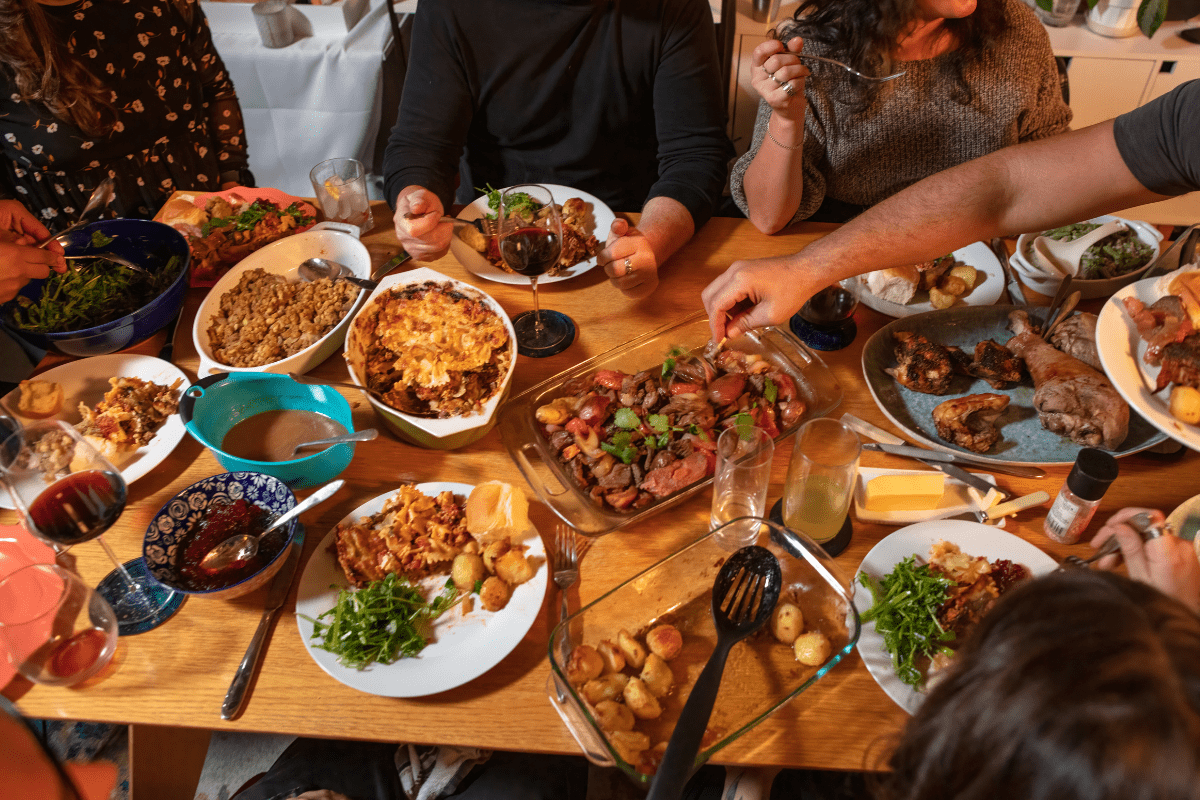Indiana's culinary identity extends far beyond corn and soybeans. The state has cultivated a distinctive food culture rooted in Native American traditions, German immigration, and Amish farming practices, producing iconic dishes that now attract national recognition.
The tenderloin that ate Indiana
Let's address the elephant-sized sandwich in the room. Indiana's breaded pork tenderloin is so ridiculously oversized that first-timers often mistake it for a practical joke. This golden-brown monster typically extends two to three inches beyond its bun on all sides, creating what food critics call "the wow factor" and what normal people call "a logistical nightmare."
The story begins in 1908 when Nick Freienstein, son of German immigrants, had the brilliant idea to take wiener schnitzel and make it more American. Working at his restaurant in Huntington, he swapped veal for pork, slapped it on a hamburger bun, and inadvertently created Indiana's unofficial sandwich. His great-great-granddaughter still serves the original recipe at Nick's Kitchen, where they marinate the pork in buttermilk for over 24 hours before breading it with saltine crackers.
Where to find the best tenderloins
The competition for Indiana's best tenderloin is fiercer than a basketball rivalry. Nick's Kitchen in Huntington holds the crown according to Visit Indiana's official vote, but don't tell that to the fanatics at other establishments.
Top contenders for tenderloin supremacy:
- Nick's Kitchen (Huntington) – original recipe
- The Mug (Greenfield) – heritage pork
- Aristocrat Pub (Indianapolis) – secret spices
- Blind Owl Brewery – chipotle variations
- Plump's Last Shot (Indianapolis) – hand-cut daily
- Wagner's Village Inn (Oldenburg) – German-style preparation
- Edinburgh Diner – classic truck-stop version
- Nickel Plate Bar (Fishers) – modern twist
The Mug in Greenfield has earned particular acclaim for sourcing heritage pigs from Tyner Pond Farm and frying their medallions in actual lard. Meanwhile, the Aristocrat Pub adds mysterious spice blends that they guard like state secrets. The result is a statewide network of over 75 restaurants on the Tenderloin Lovers Trail, each claiming superiority while secretly acknowledging they're all pretty fantastic.
Sugar cream pie and desperation's sweet revenge
Nothing says "making the best of a bad situation" quite like Indiana's official state pie. Sugar cream pie emerged from 19th-century Amish and Shaker communities who needed dessert but lacked fresh fruit, eggs, or basically anything useful. So they mixed sugar, cream, flour, and sheer determination to create what they honestly called "desperation pie."
The traditional recipe is embarrassingly simple. You combine sugar, cream or milk, and cornstarch or flour. That's it. No eggs, which confuses people expecting custard. Some old-school recipes instruct bakers to stir with their finger during baking, earning it the nickname "finger pie" and probably violating several health codes.
Wick's Pies in Winchester took this humble dessert and turned it into big business, cranking out 10,000 pies daily using a family recipe from the 1940s. Their success inspired the Indiana Foodways Alliance to create the Hoosier Pie Trail, connecting bakeries that preserve this tradition. My Sugar Pie in Indianapolis gained national recognition from People Magazine and Oprah, proving that sometimes desperation really is the mother of delicious invention.
Modern pie pilgrimage spots
Das Dutchman Essenhaus in Middlebury serves over 30 pie varieties in what claims to be Indiana's largest Pennsylvania Dutch restaurant. The sprawling complex includes a bakery where you can watch Amish women create these simple masterpieces. Gray Brothers Cafeteria in Mooresville maintains the tradition with a recipe unchanged since 1944, while Lisa's Pie Shop in Atlanta (Indiana, not Georgia) has won multiple state fair competitions.
Regional flavors that tell Indiana's story
Indiana's geography creates distinct culinary regions, each reflecting the people who settled there and the ingredients they found. Understanding these regional differences helps explain why a road trip across Indiana feels like a tour through multiple countries' kitchens.
Northern Indiana embraces its Amish roots
Northern Indiana hosts America's third-largest Amish population, concentrated in Elkhart and LaGrange counties where horse-drawn buggies share roads with tourists seeking authentic experiences. The Amish influence extends beyond quaint photo opportunities to serious food traditions.
Blue Gate Restaurant in Shipshewana serves family-style meals that could feed a barn-raising crew. Their fried chicken arrives at tables in heaping platters alongside real mashed potatoes (not the instant kind), thick egg noodles, and vegetables that actually taste like vegetables because they're grown without chemicals in nearby fields.
Traditional Amish dishes dominating northern menus:
- Beef and noodles over mashed potatoes
- Chicken and dumplings
- Apple butter
- Shoofly pie
- Homemade bread and rolls
- Pickled everything
Central Indiana's German heritage lives on
Indianapolis showcases Indiana's Germanic roots through restaurants that predate both world wars. The Rathskeller, the city's oldest restaurant dating to 1894, occupies the basement of the Athenaeum building designed by Bernard Vonnegut, grandfather of the famous author. By 1890, Germans comprised 18% of Indianapolis's population, establishing 56 cultural societies by 1910.
St. Elmo Steak House, while not German, has become Indianapolis's most famous restaurant. Their shrimp cocktail arrives with horseradish sauce so potent it clears sinuses you didn't know you had. This James Beard America's Classics winner has served the identical recipe since 1902, proving that when something works, you don't mess with it.
Modern Indianapolis embraces food trucks and brewery culture while maintaining old-school establishments. Mass Avenue has evolved into a dining destination where traditional German restaurants coexist with Vietnamese pho shops and Venezuelan arepas, reflecting the city's continuing evolution.
Southern Indiana's river influence
The Ohio River brought Southern cooking traditions upstream, creating a unique blend of Midwest meets South. Persimmons, those finicky native fruits that must be perfectly ripe or taste like eating a wool sweater, became Southern Indiana's signature ingredient.
Mitchell's Persimmon Festival draws 50,000 visitors annually to a town of 4,000. Volunteers prepare persimmon pudding from closely guarded family recipes, creating a dense, cake-like dessert that represents Indiana's only major contribution to America's dessert canon beyond sugar cream pie.
The region's barbecue shows Kentucky influence, with pulled pork and burgoo appearing on menus alongside Indiana classics. Fried catfish from the Ohio River (or at least from somewhere) remains a Friday night tradition in river towns.
Northwest Indiana's industrial appetite
The steel mills and Chicago proximity created a different food culture entirely. Polish, Serbian, and Croatian immigrants brought pierogis, cabbage rolls, and hearty stews designed to fuel hard labor. Whiting's Pierogi Fest has been named Indiana's best food festival, drawing hundreds of thousands for the three-day celebration.
3 Floyds Brewing in Munster revolutionized Indiana's beer scene with aggressive hop-forward beers like Zombie Dust pale ale. Their success sparked a craft brewing revolution across the state, with brewpubs becoming gathering places that serve food designed to pair with beer rather than the other way around.
Immigration waves continue shaping menus
Indiana's food story is really an immigration story wearing an apron. Each wave of newcomers added ingredients and techniques that became so integrated into local cuisine that we forget they were once foreign.
German immigrants established the foundation. Beyond restaurants, they created breweries, bakeries, and meat markets that defined eating habits for generations. Schnitzelbank in Jasper maintains authentic German cuisine while neighborhoods like Oldenburg preserve entire German village atmospheres. The Brau Haus there serves schnitzel and sauerkraut balls with Düsseldorf mustard in a setting that could be mistaken for Bavaria.
African American migration from the post-Civil War South brought soul food traditions that flourish in establishments like Kountry Kitchen and Simply Southern Soul Food. These restaurants preserve family recipes for oxtails, collard greens, and cornbread that traveled north during the Great Migration.
Recent Latino immigration has dramatically expanded Indiana's culinary options. With 277,558 Latino residents by 2005 representing the state's second-largest minority group, authentic Mexican restaurants now outnumber chain versions. More significantly, 78% of agricultural workers identifying as Latino influence food production at its source, creating connections between field and table that reshape both farming practices and restaurant menus.
Festivals where food becomes community
Indiana takes food festivals seriously enough to close entire towns and invite hundreds of thousands of guests. These events preserve traditions while creating economic engines for rural communities.
The Indiana State Fair's "Taste of the Fair" competition has evolved from agricultural showcase to culinary innovation laboratory. Winners receive $2,500 and Golden Tickets to compete in the World Food Championships. Recent winning entries like Sweet & Spicy Swine Pizza and Peanut Butter & Jelly Chicken Wings suggest creativity levels that would make molecular gastronomists jealous.
Must-attend Indiana food festivals:
- Persimmon Festival (Mitchell) – September
- Pierogi Fest (Whiting) – July
- Tipton County Pork Festival – September
- Indiana State Fair – August
- Schweizer Fest (Tell City) – August
- Greek Festival (Indianapolis) – June
- Rib Fest (Indianapolis) – August
- Apple Festival (Nappanee) – September
The Tipton County Pork Festival has served one-inch thick chops for over 50 years, celebrating Indiana's position as America's fifth-largest pork producer. These festivals generate millions for local economies while maintaining connections between agricultural production and cultural celebration that urbanization threatens elsewhere.
Modern chefs reimagine Hoosier classics
Indiana's contemporary culinary scene balances tradition with innovation better than a tenderloin balanced on its tiny bun. James Beard nominees now work alongside fourth-generation family restaurants, each respecting the other's contribution.
Thomas Melvin at Vida Restaurant earned two nominations for Best Chef: Great Lakes. His philosophy embraces mentorship: "I want the state of Indiana and the world to have more delicious food prepared by individuals who love the art and craft of what we do." His approach uses local ingredients in globally-inspired preparations without abandoning Indiana's culinary roots.
Salvador Fernandez at Bridges Craft Pizza & Wine Bar represents small-town success, earning his first James Beard nomination while serving Greencastle's DePauw University community. He dedicated the honor to his late mentor Greg Hardesty, demonstrating how Indiana's culinary community supports its own.
The craft beer explosion
Indiana's brewing renaissance transformed the state into America's 16th-ranked beer destination with over 200 breweries contributing $1.6 billion annually. This isn't surprising given those German roots, but the creativity level would shock 19th-century brewmasters.
Upland Brewing Company leads in popularity with nine locations experimenting with local ingredients. Sun King Brewery became Indianapolis's largest by creating approachable beers with names like Wee Mac Scottish Ale and Pachanga Mexican Lager. 18th Street Brewery in Gary pushes boundaries with barrel-aged sours that win national competitions.
The Brewers Association selected Indianapolis to host the 2025 Craft Brewers Conference, recognizing Indiana's emergence as a serious beer destination. Small towns now support brewpubs that serve as community gathering places, offering food designed specifically to pair with their beers.
Where tradition meets innovation
Indiana's culinary future looks like its past, just with better knife skills and locally-sourced ingredients. Farm-to-table isn't new here; it's how people always ate until they forgot and then remembered again. Modern chefs increasingly source from Indiana's robust farmers market network, creating seasonal menus that would seem familiar to their great-grandparents.
Food trucks democratize dining, bringing everything from Korean BBQ to gourmet grilled cheese to office parks and breweries. The annual Taste of Indy features 75 local restaurants, letting visitors sample the city's diversity without committing to full meals anywhere.
Historic businesses adapt while maintaining traditions. Fort Wayne's Famous Coney Island, America's oldest hot dog stand serving since 1914, still uses the original recipe while adding vegetarian options. This balance between preservation and evolution defines Indiana's food scene.
Planning your Indiana food adventure
The best way to experience Indiana's culinary diversity involves strategic planning and elastic waistbands. Start with the classics: get a tenderloin somewhere claiming to serve the best (they're probably right), try sugar cream pie at an Amish restaurant, and brave St. Elmo's shrimp cocktail.
Essential Indiana food experiences:
- Tenderloin at Nick's Kitchen
- Sugar cream pie from Wick's
- St. Elmo's shrimp cocktail
- Amish family-style dinner
- Craft beer tasting
- Persimmon pudding (in season)
- German fare in Oldenburg
- Pierogi in Northwest Indiana
Consider timing visits around festivals for maximum immersion. The Covered Bridge Festival in October combines food with scenic drives through multiple counties. Summer brings county fairs with 4-H competitions and deep-fried experiments. Winter might seem quiet, but that's when comfort food shines brightest in cozy restaurants.
Indiana's agricultural statistics tell one story: over one billion bushels of corn, 5.8 million acres of soybeans, top rankings in pork production. But the real story unfolds in church basements serving carry-in dinners, small-town restaurants where recipes haven't changed in decades, and innovative chefs who understand that honoring tradition doesn't mean being trapped by it.
The state's food represents the American experience condensed into bite-sized portions (except for the tenderloin, which requires multiple bites). Indigenous foundations built upon by German, Amish, African American, and Latino influences create flavors inseparable from Indiana's identity. As the World Food Championships relocate to Indianapolis and national recognition grows, Indiana stands ready to claim its deserved place in America's culinary conversation.
Yet the true measure of Indiana's food culture isn't found in awards or accolades. It lives in church suppers serving chicken and noodles over mashed potatoes (yes, carbs on carbs), county fair pie competitions where grudges last generations, and family restaurants where changing the recipe would be considered betrayal. In Indiana, food isn't just sustenance. It's heritage, community, and identity served on a plate that's probably bigger than necessary, just like that tenderloin spilling magnificently over its bun.





